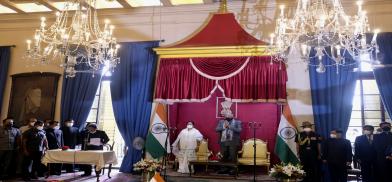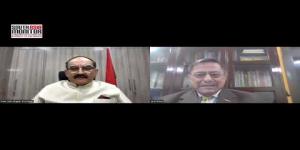India assembly poll verdict: Can Bengal’s Mamata Banerjee emerge as opposition’s PM nominee?
Mamata Banerjee, who is being touted in some circles as a possible prime ministerial candidate of India’s opposition parties after an epic victory over Prime Minister Narendra Modi's BJP in regional polls, on Wednesday took oath as chief minister of West Bengal for the third time in a row

Mamata Banerjee, who is being touted in some circles as a possible prime ministerial candidate of India’s opposition parties after an epic victory over Prime Minister Narendra Modi's BJP in regional polls, on Wednesday took oath as chief minister of West Bengal for the third time in a row. If she completes her five-year term, the redoubtable 66-year-old politician, who calls herself a street fighter, will be in power in the state of 92 million people for 15 years.
State governor Jagdeep Dhankhar administered the oath of office and secrecy to Banerjee, who led her party Trinamool Congress to a huge win over the BJP in the state assembly polls despite a vigorous campaign by Modi himself - notwithstanding the raging pandemic in the country - and other bigwigs of his government and party. They included his chief political strategist and Home Minister Amit Shah who put all they had into the fray to wrest control of the key eastern state that has so far eluded rightwing control.
The feisty Trinamool leader, a former milk booth vendor and still known for her spartan lifestyle, has emerged as one of the strongest voices in the country against the BJP-led central government and has vowed to unseat them from power in New Delhi.
But whether she is acceptable as a common candidate of a feuding opposition, that has always been at loggerheads with each other, remains to be seen as general elections are still three years away and the country's first priority now is to battle the challenge of the pandemic that has wrought havoc, with deaths and family devastation, in the country of nearly 1.35 billion people.
Banerjee had earlier grabbed international headlines in 2011, when she ended the 34-year rule of the Left Front – the world's longest serving communist government in a multi-party democratic set-up - riding on an anti-farmland acquisition movement in the state.
In the prolonged eight-phase polls this time, the Trinamool Congress retained its sway over West Bengal with an over two-thirds majority by winning 213 seats, its best performance, even though Banerjee herself lost from Nandigram constituency to her former close aide and now BJP leader Suvendu Adhikari.
Despite falling short in its charge for power, the BJP for the first time emerged as the main opposition in the state assembly, its strength going up to 77 from only three seats it won five years back.
The Congress and the Communist led Left Front, who fought as part of the newly formed Sanjukta Morcha (United Front), failed to win even a single seat. Both had ruled Bengal between them for six decades previously and now stand virtually eclipsed in this highly politically conscious state.
The Trinamool’s spectacular show in part could be attributed to the huge support it got from the Muslim community, who comprise at least 27 per cent of the state population. This more or less explains the Congress’ eclipse in the state, where it so long had a strong base in the three Muslim majority districts – Murshidabad, Malda and North Dinajpur.
In the north eastern state of Assam, which had been singed by a volatile movement against the Citizenship (Amendment) Act, the BJP-led NDA retained power comfortably.
In a determined bid to throw a strong challenge to the NDA, the Congress had expanded the United Progressive Alliance (UPA), which it spearheads, by including the predominantly Muslim outfit AIUDF. But the alliance could grab only 50 of the 126 seats. The NDA won 75.
It was a difficult pill to swallow for the Congress, which had been hoping to exploit the gains of the anti-CAA agitation to show the doors to the BJP-led regime.
The CAA seeks to provide Indian nationality to Hindus, Christians, Sikhs, Parsis, Jains and Buddhists fleeing persecution in Pakistan, Afghanistan and Bangladesh before December 31, 2014 but specifically excludes Muslims.
In the southern state of Tamil Nadu, one of the country's most industrialised state after Maharashtra, the regional outfit DMK spearheaded Secular Progressive Alliance (SPA), of which the Congress is a partner, wrested the state from the BJP ally AIDAMK, which had been ruling the state for the last ten years.
In the final vote count, the SPA won 159 and the NDA 75 in the 234-member assembly. DMK chief M K Stalin, son of the late Dravidian leader M Karunanidhi, is scheduled to be sworn in chief minister on May 7.
Another southern state Kerala, where power has for long changed hands in every assembly poll between the Congres and Communist-ruled alliances, charted a new course as the CPI-M led Left Democratic Front retained power by winning over two-thirds of the seats. The Congress-led United Democratic Front was left way behind, despite a spirited campaign by former Congress chief Rahul Gandhi, who is also an MP from the state,
Chief Minister and CPI-M leader Pinarayi Vijayan is all set to be sworn in for his second stint in office.
The small neighboring union territory of Puducherry saw the NDA snatching power from the Congress-led UPA.
It was overall a poor show by the Congress, which failed to unseat the BJP led government in Assam and the ruling LDF in Kerala, lost power in Puducherry, and failed win a single seat in West Bengal. The Congress’ only consolation victory came in Tamil Nadu, where it played second fiddle to the DMK.
The results were another thumbs down to the leadership of the Gandhi family, particularly Rahul Gandhi, the son, grandson and great grandson of former Indian prime ministers.
Following are the final Assembly poll results:
ASSAM
Total seats 126
National Democratic Alliance (NDA) 75 (bjp60, AGP 9, UPPL 6)
United Progressive Alliance 50 (Congress 29, AIUDF 16, BPF 4, CPI-M 1)
Independent 1
Kerala
Total seats 140
Left Democratic Front 99 (CPI-M 62, CPI 17, KC(M) 5, JD(S) 2, NCP 2, KC(B), INL, LJD, NSC, C(S), JKC 1 each, Independents 5)
United Democratic Front 41 (Congress 21, IUML 15, KC 2, RMPI, NCK and KC (Ja) 1 each)
Tamil Nadu
Total seats: 234
Secular Progressive Alliance 159 (DMK 128, Congress 18, MDMK and VCK 4 each, CPI and CPI-M 2 each, MMK 1)
NDA 75 (AIADMK 65, PMK 5, BJP 4, PBK 1)
West Bengal
Total seats 294
Election held 292
Trinamool Congress 213
BJP 77
Rashtriya Secular Majlis Party 1
Independent 1
Puducherry
Total seats 30
NDA 16 (AINRC 10, BJP 6)
UPA 9 (DMK 6, Congress 2, Independent 1)
Independents 5
(SAM)









Post a Comment